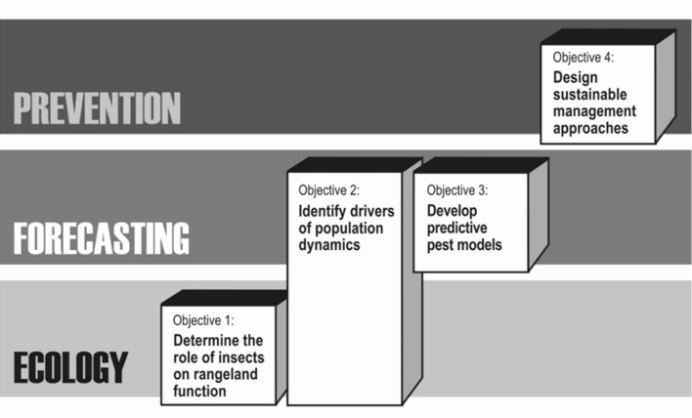| Sidney, MT ARS Research |

|
Grasshopper and Mormon Cricket Research
An Overview of Grasshopper Management Research at the USDA-ARS Northern Plains Agricultural Research Laboratory in Sidney, Montana
Grasshoppers and Mormon crickets significantly damage rangeland and crop productivity in the Central and Western United States. Grasshoppers and Mormon crickets consume ~$1.7 billion of forage annually in the U.S. These pests are high priority targets for ranchers, farmers and federal and state land managers, since current control strategies are inadequate, costly and/or result in unacceptable environmental impacts due to the historical reliance on broad spectrum insecticides. The long-term goal of ARS research at the Northern Plains Agricultural Research Lab in Sidney, MT, is to develop innovative, environmentally sound and sustainable management alternatives for control of these pests.
Research Objectives:
Grassland habitats dominate the Great Plains, whether managed for grazing or planted as crops (primarily dryland wheat). As a result, these grassland systems share many pests and beneficials, and similar ecological processes potentially influence population dynamics of grasshoppers, their competitors, pathogens and predators. Improving the understanding of the ecology of these grassland organisms will enable the development of prevention and intervention management strategies. The proposed research is divided into four broad objectives representing areas where ecological research is lacking and vitally needed, and will lead to the development of sustainable and innovative pest management strategies (Fig. 1). As insects are often the dominant rangeland herbivores, basic ecological research is needed to determine the role of these insects on rangeland ecosystem function and production which also affects forecasting (Objective 1). Identifying climatic and biotic ecological drivers of pest population dynamics will be key to managing insect pests and anticipating outbreaks in a changing climate (Objective 2). Developing practical models to predict when these pests will exceed economic thresholds will facilitate more effective integrated pest management (IPM) (Objective 3). Designing habitat management approaches that prevent pest problems will provide needed alternatives to pesticide control (Objective 4).

Figure 1: The relationship between the conceptual thematic framework of ecology, forecasting and prevention and the specific research objectives designed with the long-term goal of developing ecologically-based and economically practical management strategies that maintain pest populations at sub-economic levels via biological and cultural means.
Participating Scientists:
Dr. David Branson, ARS Research Entomologist (Grasshopper Ecology)
Dr. Robert Srygley, ARS Research Ecologist (Mormon Cricket Ecology)
Vacant, ARS Research Ecologist (Pest Outbreak Modeling)
ARS Grasshopper Publications:
Rangeland Insect Laboratory Publications, 1918 to 1996
Complete bibliography of research publications produced by the USDA-ARS Rangeland Insect Laboratory in Bozeman, Montana. The Rangeland Insect Laboratory was located at Bozeman, MT for over 65 years and incorporated into the Northern Plains Agricultural Research Laboratory in Sidney, MT in 1996. Copies of individual articles from this archive can be requested by contacting USDA-ARS Northern Plains Agricultural Research Lab, Grasshopper Reprint Requests, 1500 N. Central Ave., Sidney, MT 59270.
USDA-ARS Grasshopper Publications, 1996 to Present
